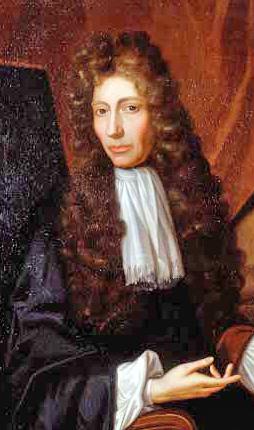What is Boyle's Law?
 Michael Anissimov
Michael Anissimov
Boyle's Law is a basic law in chemistry describing the behavior of a gas held at a constant temperature. The law, discovered by Robert Boyle in 1662, states that at a fixed temperature, the volume of gas is inversely proportional to the pressure exerted by the gas. In other words, when a gas is pumped into an enclosed space, it will shrink to fit into that space, but the pressure that the gas puts on the container will increase. Boyle's Law can be written out mathematically:
In this equation, P = pressure and V = volume.
Boyle's Experiment

To prove the law, Boyle pumped oxygen (a gas) into a J-shaped tube of glass that was sealed at one end. Using a burner to keep the oxygen at a constant temperature, he then poured different amounts of mercury into the tube, which varied the pressure on the oxygen. He found that the more pressure he applied, the smaller the volume of the oxygen, and this reduction happened at a constant rate.
Boyle's Law specifically relates to an ideal gas — that is, a theoretical gas that is made up of random particles that do not interact. Although no real gasses are ideal gasses, most do display these ideal characteristics under normal conditions.
Real-World Examples
One example of Boyle's Law in action can be seen in a balloon. Air is blown into the balloon; the pressure of that air — a gas — pushes on the rubber, making the balloon expand. If one end of the balloon is squeezed, making the volume smaller, the pressure inside increases, making the un-squeezed part of the balloon expand out. There is a limit to how much the gas can be compressed, however, because eventually the pressure becomes so great that it causes the balloon (or any container) to break.
A different example is a syringe for taking blood. An empty syringe has a fixed amount of gas (air) in it; if the plunger is drawn back without the needle end being inserted into anything, the volume of the tube will increase and the pressure will drop, causing more air to move into the tube to equalize the pressure. If the syringe is inserted into a vein and the plunger drawn back, blood will flow into the tube since the pressure in the vein is higher than the pressure in the syringe.
Another way of describing Boyle's law is that when pushed, a gas tends to push back. Without the massive amount of gravity holding them together, the solar system's gas planets would rapidly diffuse in all directions, quickly depressurizing. In this case, the pressure of gravity regulates the volume of the gases around these planets.
Charles and Guy-Lussac's Law
The inverse of Boyle's Law is Charles and Gay-Lussac's Law, named for the two French scientists who discovered it. Charles and Gay-Lussac's Law shows that the volume of a gas increases or decreases according to temperature. Written out mathematically, the law looks like this:
In this equation, V = volume and T = temperature. While Boyle's Law focuses on constant temperature and changing pressure, Charles and Gay-Lussac's Law focuses on changing temperature.
AS FEATURED ON:
AS FEATURED ON:











Discussion Comments
Boyle's Law: 1.00 L of gas at a standard temperature and pressure is compressed to 473 mL. What is the new pressure of the gas?
good but needs graphical explanation of boyles law.
how is this law useful?
how to look for the right solvent?
what is the experiential explanation to this concept?
During a post mortem where a respiratory disease is suspected, you have been asked to regulate the pressure needed to inflate the lungs to their full capacity with is assumed to be 6 litres. the current capacity of the deceased is 3400ml and the pressure recorded at the capacity is 180kpa.
Applying v1p1=v2p2 find the pressure needed to reach the desired lung volume. Please help!
If you are assuming a constant temperature, the original volume was 65.42 L.
What's the answer for the question?
When l75.47 g of carbon dioxide gas were changed from 49,715.88 mmHg to 244.92 atm, what was the original volume (V) if the new volume was measured at 8.58 l? Put your answer in two decimal places.
Post your comments